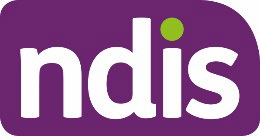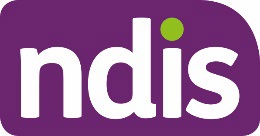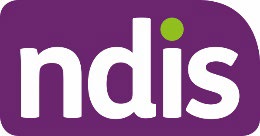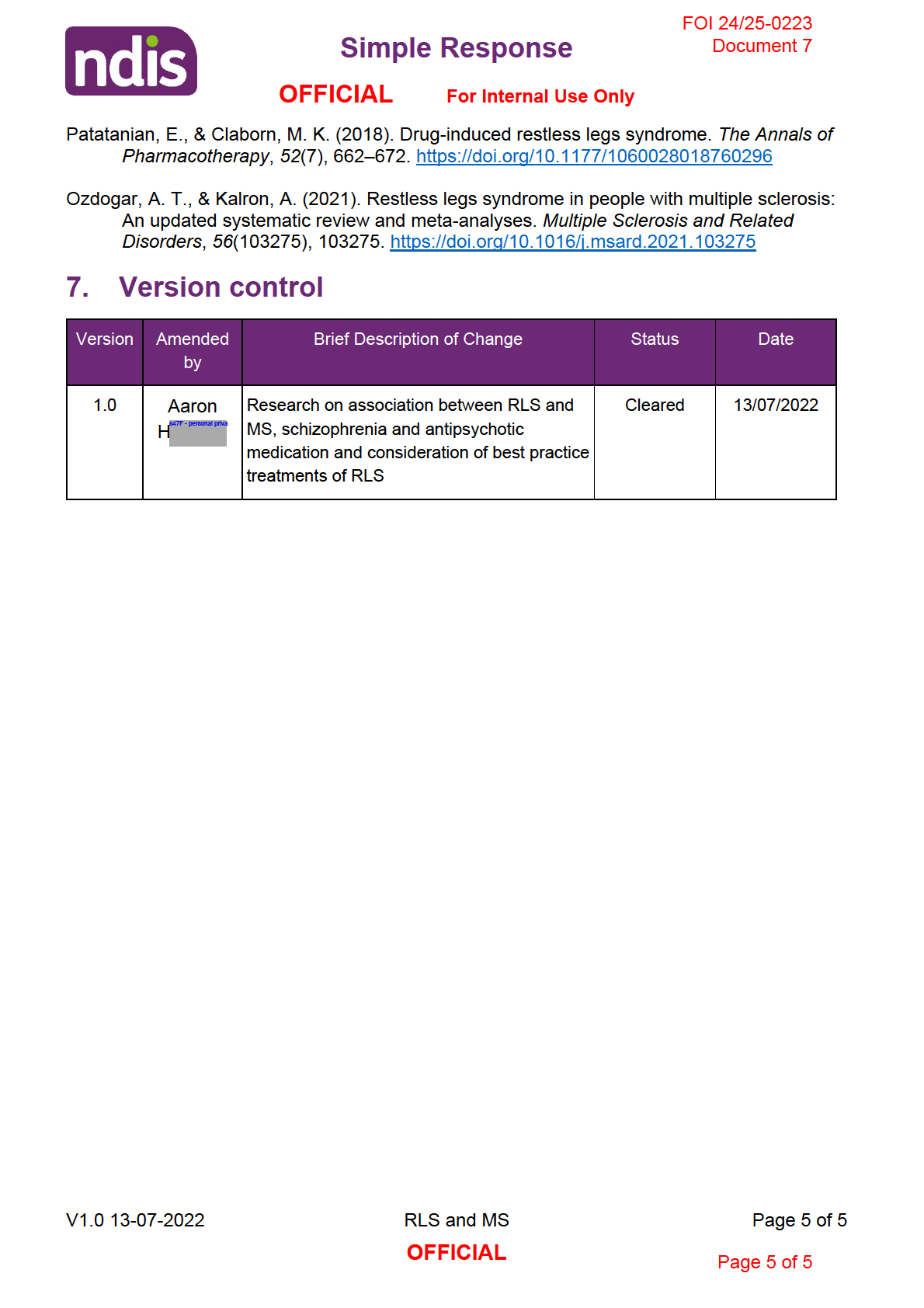
FOI 24/25-0223
Simple Response
Document 7
OFFICIAL
For Internal Use Only
Restless leg syndrome associated with Multiple
Sclerosis, schizophrenia and antipsychotic
medication
The content of this document is OFFICIAL.
Please note:
The research and literature reviews collated by our TAB Research Team are not to be
shared external to the Branch. These are for internal TAB use only and are intended to
assist our advisors with their reasonable and necessary decision-making.
Delegates have access to a wide variety of comprehensive guidance material. If
Delegates require further information on access or planning matters, they are to call the
TAPS line for advice.
The Research Team are unable to ensure that the information listed below provides an
accurate & up-to-date snapshot of these matters
Research question: Is restless legs syndrome associated with multiple sclerosis,
schizophrenia or antipsychotic medication? What is the best practice management for restless
legs syndrome associated with multiple sclerosis?
Date: 13/07/2022
Requestor: s47F - personal privacy
Endorsed by s47F - personal privacy
: Katrin R
s47F - personal
Researcher: Aaron Hs47F - personal priva
Cleared by: Stephanie Ps47F - personal
privacy
1. Contents
Restless leg syndrome associated with Multiple Sclerosis, schizophrenia and antipsychotic
medication .................................................................................................................................. 1
1.
Contents ....................................................................................................................... 1
2.
Summary ...................................................................................................................... 2
3.
Restless legs syndrome and Multiple sclerosis ............................................................. 2
4.
Restless legs syndrome, schizophrenia and anti-psychotic medication ........................ 2
5.
Treatment for restless legs syndrome associated with MS ........................................... 3
V1.0 13-07-2022
RLS and MS
Page 1 of 5
OFFICIAL
Page 1 of 5

FOI 24/25-0223
Simple Response
Document 7
OFFICIAL
For Internal Use Only
6.
References ................................................................................................................... 4
7.
Version control .............................................................................................................. 5
2. Summary
Restless legs syndrome (RLS) is a neurological sensorimotor disease which often disturbs
sleep. Symptoms become worse during periods of inactivity or rest, particularly at night.
Moving can alleviate symptoms in the short term. RLS is associated with multiple sclerosis
(MS), schizophrenia and some antipsychotic medications. Treatment can include lifestyle
changes or medication though it is not known how the commonly used drugs interact with MS
symptoms or commonly prescribed MS drugs. There is some evidence that exercise alleviates
symptoms of RLS in the general population and in people with MS, however further evidence
is required to demonstrate efficacy in people with MS.
3. Restless legs syndrome and Multiple sclerosis
There is consensus in the research literature that incidence of RLS is higher in MS than in the
general population. However, a 2021 systematic review compared 19 prevalence studies and
found significant heterogeneity in prevalence rate, between 13.2% and 65.1%. The mean
prevalence based on these studies is 27.5% (Ozdogar & Kalron, 2021). This is similar to
recent studies which found a prevalence rate of 23.3% in a sample of 120 (Lebrato Hernandez
et al, 2022), 23.9% in a sample of 117 (Monschein et al, 2021), 31.3% in a sample of 102
(Gunes et al, 2021).
The reason for the higher prevalence of RLS in MS in not known. Possible mechanisms can
include genetic factors, demyelinated lesions localized in the basal ganglia, dopaminergic
system dysfunction, or iron metabolism disorders in the CNS. RLS may also be caused by
side-effects of disease modifying treatments (Ozdogar & Kalron, 2021). Of note, both
Monschein et al (2021) and Lebrato Hernandez et al (2022) found no statistically significant
correlation between RLS and disease modifying treatment.
Some correlations are observed in various studies between RLS and age, sex, severity of MS
symptoms or progression of MS symptoms. However, Ozdogar & Kalron (2021) observe that
most studies find no statistically significant correlations between disability, disease duration,
type of MS, age or sex.
4. Restless legs syndrome, schizophrenia and anti-
psychotic medication
People with schizophrenia often have associated sleep disorders including insomnia, sleep
apnoea or RLS (Kaskie et al, 2017). Antipsychotic medication used to treat schizophrenia is
also linked with RLS. For example, Elrassas et al found that of 200 people treated with
antipsychotics or antidepressants, 40% had RLS (Elrassas et al, 2022). Patanian and Claborn
V1.0 13-07-2022
RLS and MS
Page 2 of 5
OFFICIAL
Page 2 of 5

FOI 24/25-0223
Simple Response
Document 7
OFFICIAL
For Internal Use Only
(2018) find some evidence of RLS associated with the antipsychotics haloperidol, olanzapine,
clozapine, quetiapine, risperidone, asenapine, and lurasidone.
5. Treatment for restless legs syndrome associated with
MS
The International Restless Legs Syndrome Study Group lists essential diagnostic criteria:
1. An urge to move the legs usually but not always accompanied by or felt to be caused by
uncomfortable and unpleasant sensations in the legs.
2. The urge to move the legs and any accompanying unpleasant sensations begin or
worsen during periods of rest or inactivity such as lying down or sitting.
3. The urge to move the legs and any accompanying unpleasant sensations are partially or
totally relieved by movement, such as walking or stretching, at least as long as the
activity continues.
4. The urge to move the legs and any accompanying unpleasant sensations during rest or
inactivity only occur or are worse in the evening or night than during the day.
5. The occurrence of the above features are not solely accounted for as symptoms primary
to another medical or a behavioral condition (e.g., myalgia, venous stasis, leg edema,
arthritis, leg cramps, positional discomfort, habitual foot tapping). (International Restless
Legs Syndrome Study Group, 2012)
Of note, criteria 3 states that symptoms are fully or partially relieved by movement at least as
long as the activity continues. The National Institute of Neurological Disorders and Stroke RLS
Factsheet reiterates that moving the affected limbs may provide temporary relief from
symptoms (National Institute, 2017; Browne, 2021).
First-line treatment for RLS may involve dietary or lifestyle changes, dopaminergic drugs or
anti-seizure medication in the general population. Opioids and benzodiazepines may also be
used (National Institute, 2017). However, it’s unclear how drugs used to treat RLS interact with
MS symptoms or commonly prescribed MS drugs. There is some evidence that non-
pharmacological treatments such as repetitive transcranial magnetic stimulation, exercise,
compression devices, counterstrain manipulation, and infrared therapy are effective as
treatments for RLS. However, the quality of evidence is not high and further evidence is
required to recommend treatment (Ozdogar & Kalron, 2021; Harrison et al, 2019).
In particular, further evidence is required to draw conclusions about optimal treatment for
people with MS experiencing RLS (Ozdogar & Kalron, 2021). Cederberg and Motl (2021)
showed increasing lifestyle physical activity (mainly step count in daily activities) could result in
a 30% reduction in RLS symptoms in a treatment group of 8 people with MS. While this study
shows feasibility, further research is required.
V1.0 13-07-2022
RLS and MS
Page 3 of 5
OFFICIAL
Page 3 of 5

FOI 24/25-0223
Simple Response
Document 7
OFFICIAL
For Internal Use Only
6. References
Assimakopoulos, K., Karaivazoglou, K., Skokou, M., Kalogeropoulou, M., Kolios, P., Gourzis,
P., Patrinos, G., & Tsermpini, E. (2018). Genetic variations associated with sleep
disorders in patients with schizophrenia: A systematic review.
Medicines (Basel,
Switzerland),
5(2), 27. https://doi.org/10.3390/medicines5020027
Browne, Adam. (2021).
Developing your coping strategy for restless legs. MS Australia.
https://www.msaustralia.org.au/news/developing-your-coping-strategy-for-restless-legs/
Cederberg, K. L. J., & Motl, R. W. (2021). Feasibility and efficacy of a physical activity
intervention for managing restless legs syndrome in multiple sclerosis: Results of a pilot
randomized controlled trial.
Multiple Sclerosis and Related Disorders,
50(102836),
102836. https://doi.org/10.1016/j.msard.2021.102836
Elrassas, H. H., Elsayed, Y. A. R., Abdeen, M. S., Shady, M. M., Shalash, A., & Morsy, M.
(2022). Restless Legs Syndrome among patients receiving antipsychotic and
antidepressant drugs.
Human Psychopharmacology,
37(2), e2817.
https://doi.org/10.1002/hup.2817
Güneş, T., Emre, U., Erdal, Y., & Yalin, O. Ö. (2021). Restless Legs Syndrome in multiple
sclerosis.
Noro Psikiyatri Arsivi,
58(2), 94–98. https://doi.org/10.29399/npa.23429
Harrison, E. G., Keating, J. L., & Morgan, P. E. (2019). Non-pharmacological interventions for
restless legs syndrome: a systematic review of randomised controlled trials.
Disability
and Rehabilitation,
41(17), 2006–2014. https://doi.org/10.1080/09638288.2018.1453875
International restless legs syndrome study group
. (2012).
Diagnostic Criteria. Irlssg.org.
Retrieved July 13, 2022, from http://irlssg.org/Diagnostic-criteria
Kaskie, R., Graziano, B., & Ferrarelli, F. (2017). Schizophrenia and sleep disorders: links,
risks, and management challenges.
Nature and Science of Sleep,
9, 227–239.
https://doi.org/10.2147/nss.s121076
Lebrato Hernández, L., Prieto León, M., Cerdá Fuentes, N. A., Uclés Sánchez, A. J., Casado
Chocán, J. L., & Díaz Sánchez, M. (2022). Restless legs syndrome in patients with
multiple sclerosis: evaluation of risk factors and clinical impact.
Neurología (English
Edition),
37(2), 83–90. https://doi.org/10.1016/j.nrleng.2018.12.018
Monschein, T., Schestak, C., Schillerwein-Kral, C., Leutmezer, F., Berger, T., Bsteh, G., &
Seidel, S. (2021). Restless Legs Syndrome in Multiple Sclerosis: Risk factors and effect
on sleep quality - a case-control study.
Multiple Sclerosis and Related Disorders,
51(102916), 102916. https://doi.org/10.1016/j.msard.2021.102916
National Institute of Neurological Disorder and Stroke. (2017). Restless Legs Syndrome Fact
Sheet.
National Institutes of Health. NIH Publication No. 17-4847. Available from:
https://www.ninds.nih.gov/health-information/patient-caregiver-education/fact-
sheets/restless-legs-syndrome-fact-sheet
V1.0 13-07-2022
RLS and MS
Page 4 of 5
OFFICIAL
Page 4 of 5





